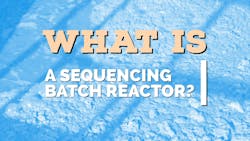What is a sequencing batch reactor?
In wastewater treatment, a sequencing batch reactor (SBR) is a fill-and-draw type of wastewater treatment process. A SBR can be used to treat both municipal and industrial wastewater.
While some literature sources indicate the SBR as a single tank, other literature sources report it to be as multiple tanks. The SBR system involves single or multiple tanks depending on the scale of the operation and on the composition of the wastewater influent.
Differences between SBR and activated sludge system
The processes occurring in the SBR and conventional activated sludge are the same or similar. The main difference between an SBR and an activated sludge system is that in an SBR, the microbial metabolic breakdown of chemicals in the wastewater influent and the solid/liquid separation take place at different times and thus, the SBR is known as time rather than space oriented. Timed-controlled sequences occur in the SBR.
The treatment efficiency might be similar or comparable between an SBR and activated sludge process, depending on the operational parameters. In a published study, the removal efficiency of nitrate was 98.1% in the SBR plant and 89.7% for the activated sludge plant. The total nitrogen removal efficiency was 84.1% for the SBR plant and 79.7% for the activated sludge plant.
How does a sequencing batch reactor work?
There are five basic phases in a SBR operation cycle: fill, react, settle, draw, and idle.
1. Fill phase
During the fill phase, the SBR tank containing the active biomass left behind from the last cycle, receives the raw wastewater. There are three variations of the fill phase: static fill, mixed fill, or aeration fill. During static fill, the influent wastewater is added to the biomass without mixing. This biomass is already present in the SBR tank.
2. React phase
In the react phase, biological reactions that were initiated in the fill phase are completed. A high degree of nutrients is also removed in the react phase. The react phase is controlled by the presence of air to create anaerobic, anoxic, or aerobic conditions and thus, it could be a mixed react mode or an aerated react mode. Furthermore, the mixed react mode might have aerobic, anoxic, and anaerobic conditions while the aerated react mode has aerobic conditions.
3. Settle phase
There is no inflow or outflow in the settle phase, i.e., quiescent conditions are present in the settle phase. Clarification of the wastewater occurs in the settle phase.
4. Draw phase
In the draw phase, also known as the decant phase, a decanter is used to decant the treated supernatant generated after the react phase. The time required for the draw phase can be more than 30% of the total cycle time.
5. Idle phase
In the idle phase which is the period between draw and fill, the biomass is mixed and the excess sludge is discarded. Other variations might be present, depending on the operating strategy.
Process control strategy for SBR
The chemical oxygen demand (COD), biological oxygen demand (BOD), total suspended solids (TSS), and various forms of nitrates and phosphates, in addition to the pH are some of the parameters that require monitoring for the optimal and efficient performance of the SBR in wastewater treatment. The chemical composition of the influent and the SBR phases affect these parameters.
During the different processes in a conventional SBR, nitrification and denitrification occur and lead to fluctuation in the COD, pH, and concentration of the different nitrate and phosphate forms, among other parameters. Temperature also affect these parameters.
Is a sequencing batch reactor aerobic or anaerobic?
SBR could be aerobic or anaerobic depending on the wastewater treatment system. The fill and the react phases could be anoxic or aerated. The anoxic fill environment is to allow the proliferation of microorganisms with good settling characteristics and in the aerated fill environment, nitrification and denitrification occurs.
The different variations of the SBR technology
Some of the different variations of the SBR technology are described here. They are used depending on the capacity and the outcome requirements of the wastewater treatment plant.
Cyclic activated sludge process
The cyclic activated sludge process uses a single basin that accommodates a variable volume and operates in an alternating mode. The activated sludge from the main aeration zone is recirculated into a selector zone. The selector allows for the uniform metabolic activities of the sludge.
A patented invention on the cyclic activated sludge system applicable to wastewater treatment comprises of water collection regulator tank connected to a sludge cooling tower. This in turn is connected to a coagulative precipitation tank. The invention also contains a bio-filter tank in addition to a sludge tank and claims high efficiency removal of organic carbon.
UNITANK technology
The basic UNITANK configuration consists of a single tank that is divided into three connected compartments in a series. The compartments on either sides function as aeration and sludge settling tanks while the middle compartment functions only as an aeration unit. This configuration, in addition to allowing anaerobic or anoxic conditions, also allows the internal recirculation of mixed liquor.
According to a research article that assessed UNITANK as a technology, UNITANK is more suitable for small to relatively mid-size wastewater treatment plants. It also has a low construction cost and a high rate of organic carbon removal.
Intermittent cycle extended aeration system (ICEAS)
In the ICEAS, influent wastewater flows into the reactor continuously and the inflow is even in all the tanks due to the presence of a distributor box. There is also a pre-react zone with a high food to microorganism (F/M) ratio that inhibits filamentous growth and enhances the settling of sludge. ICEAS can remove more than 90% organic compounds and nutrients.
What are the advantages and disadvantages of SBR?
Advantages
- Operating flexibility and control
- Potential cost saving by eliminating other equipment
- Toleration for the variation in the flow rate and influent loading
- Potential for high efficiency in the treatment for TSS, nitrogen, and phosphate
- Potential for using the biogas produced from the anaerobic sludge digestion as an energy source
- The compact design requires less space than the activated sludge system
Disadvantages
About the Author
Saleha Kuzniewski
Saleha Kuzniewski, Ph.D. has authored several publications in the fields of scientific research, biotechnology, and environmental regulations. She is the winner of the 2023 Apex award for publication excellence. She is also the founder of Environmental Remediation & Innovations, LLC. Kuzniewski can be reached at [email protected].


